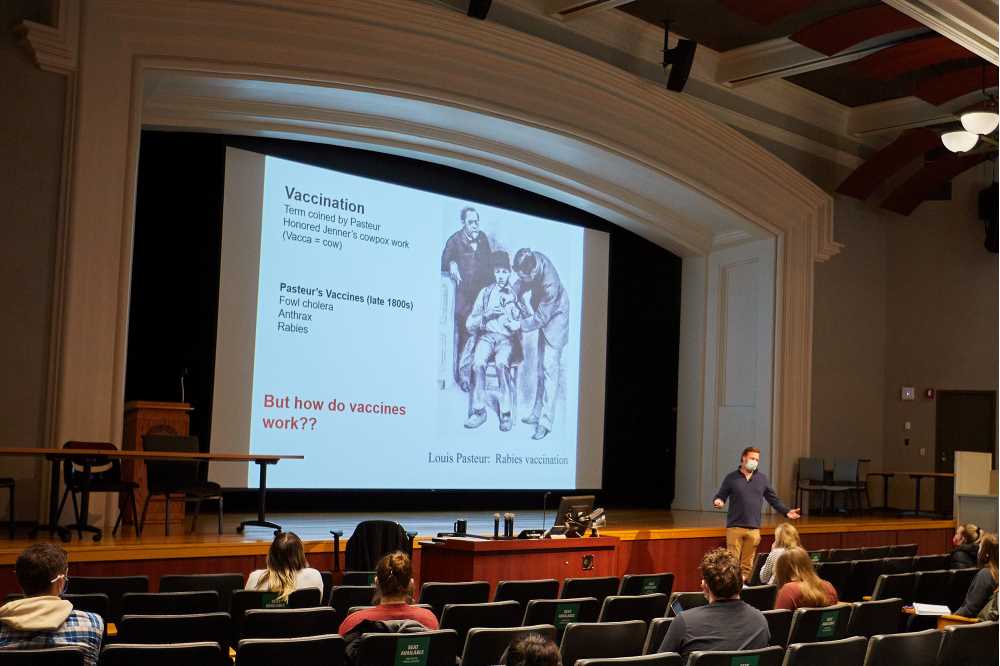
Peter Wilker, associate professor of microbiology, lectures during an immunology class at UW-La Crosse.
As vaccine eligibility opens across Wisconsin and the nation, people finally have hope for a return to normalcy. Still, the road to herd immunity requires people to sign up and get their shots. To help eliminate misconceptions surrounding vaccinations, UW-La Crosse infectious disease expert Peter Wilker addresses some common questions and concerns about getting vaccinated.
Wilker, an associate professor of microbiology, has a master of public health degree in epidemiology and a doctoral degree in immunology. He has been studying pandemic and seasonal influenza viruses for more than a decade and teaches UWL courses in Immunology, The Global Impact of Infectious Disease, and Infectious Disease Epidemiology.
Q: When we hear that a vaccine is 95 percent effective or 75 percent effective, what does that mean? How is vaccine efficacy measured?
A: Vaccine efficacy and effectiveness both describe the extent to which a vaccine reduces the risk of an infectious disease. In the COVID-19 vaccine trials, researchers vaccinated some study participants and administered a placebo to others. The participants were followed to see how many people in each group later developed COVID-19. A hypothetical example can help in understanding how efficacy is calculated. Imagine a vaccine study with 10,000 participants in each group. Researchers counted 1,000 COVID-19 cases in the placebo group and only 100 cases in the vaccinated group. This means the vaccine prevented 90% of COVID-19 cases that would have occurred had the individuals not been vaccinated, and so has an efficacy of 90%.
Q: The available COVID-19 vaccines have different efficacies. Does this mean one is better than the other?
A: All of the available vaccines have prevented hospitalizations and death from COVID-19. Comparing efficacies between the different available vaccines is a bit like comparing apples to oranges. The differences you may have read about are primarily related to the specific outcomes measured in each trial and whether variants were circulating when the trial was performed.
Q: Will the vaccine stop a person’s ability to spread the virus?
A: We are still learning about this, but there are recent reports that the mRNA-based COVID-19 vaccines prevent approximately 90% of infections. You can’t spread the virus if you aren’t infected, so these vaccines are an important public health tool to stop the spread. I expect the other types of vaccines will have a similar effect. No vaccine works perfectly in all people, however, so there will still be some individuals who become infected and spread the virus to others despite vaccination.
Q: If I already had COVID-19, am I immune? Do I still need to get the vaccine?
A: The current recommendations state that people who have had COVID-19 should still receive a COVID-19 vaccine. People who have had COVID-19 may be immune, but there isn’t data to directly support this yet. There is no guarantee that a prior infection generated an immune response that would adequately protect you from becoming re-infected later. In contrast, the vaccine trials have scientifically shown that the COVID-19 vaccines very effectively prevent disease for at least six months.
Q: Will the vaccines we have now protect us against virus variants? Will we need to get new shots every year like we do with the flu?
A: Viruses like the one that causes COVID-19 can continually mutate and give rise to new variants. The COVID-19 vaccines were designed prior to the emergence of these variants. Vaccine efficacy appears to be somewhat lower with the variant strains, but the vaccines still effectively prevent severe COVID-19 disease. The virus will continue to change over time and there may be a future need to recalibrate the vaccines to target the most common variants and have people revaccinated as we do for influenza.
Q: These vaccines were developed so quickly. Are they really safe?
A: Yes, COVID-19 vaccines have a very good safety profile. Each vaccine has gone through rigorous clinical trials involving tens of thousands of participants. The Food and Drug Administration reviews these data before authorizing widespread use. Additionally, there is ongoing vaccine safety monitoring, and these data continue to support the safety of COVID-19 vaccination. Long-lasting or severe side effects are extremely rare and are outweighed by the much higher risk of severe COVID-19 disease. The science behind these types of vaccines is not new. They’ve been intensively researched for years.
Q: Can I get COVID-19 from the vaccine?
A: No. None of the currently licensed vaccines contain the live virus. The vaccine cannot cause COVID-19 and will not cause a positive COVID-19 test.
Q: Can vaccine side effects be contagious?
A: No. The most common side effects that follow vaccination against COVID-19 and other infectious diseases are due to the activation of the body’s immune system. The side effects cannot spread to others.
Q: How do vaccines work?
A: Vaccines work by stimulating an immune response that helps the body fight an infection in the future. The COVID-19 vaccines target a spike-like protein that the virus uses to get into cells and start an infection. Upon receiving a COVID-19 vaccine, your body’s immune system creates antibodies against this spike-like viral protein. If a vaccinated person is later exposed to the COVID-19 virus, the antibodies stick to this spike-like protein and flag the virus for destruction before it has a chance to infect cells and cause disease.
Q: Why does one vaccine need two doses while another only needs one?
A: The ultimate goal of any vaccine is to generate protective immunity. While researchers would ideally like to accomplish this using a single vaccine dose, sometimes one dose is not sufficient and a second “booster” vaccination is required to achieve the desired level of protection. The two-dose vaccines (Moderna and Pfizer/BioNTech) are designed differently than the one-dose vaccine (Johnson and Johnson), which may contribute to the different dose requirements.
- Tagged people: Peter Wilker
- Tagged departments: Microbiology
- Tagged keywords: COVID-19 pandemic and Wellness
